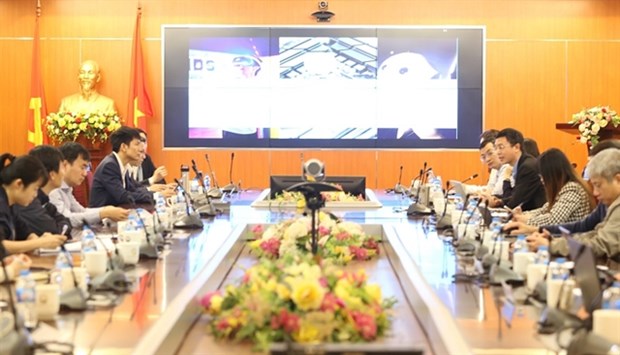Import tax exemption to benefit domestic ICT industry
The information and communication technology sector has grown by 6-9% each year and has often exceeded the country’s GDP growth rate in recent years, attendees were told at workshop held by the Ministry of Information and Communications (MIC).
 At the workshop on policies for import and export of raw materials, supplies, components and information technology products. (Photo: mic.gov.vn)
At the workshop on policies for import and export of raw materials, supplies, components and information technology products. (Photo: mic.gov.vn)MIC held the workshop on policies for the import and export of raw materials, supplies, components and information technology products; and disseminated Circular 25/2022/TT-BTTTT in Hanoi on March 29.
The Authority of Information Technology and Communication Industry said Resolution 23-NQ/TW dated March 22, 2018, of the Politburo set out the orientation for the national industrial development towards 2030.
The resolution identifies the development of the information technology industry, in which the electronics industry is the main path. It also set a goal to reach an advanced level by 2030, meeting the requirements of the fourth industrial revolution in order to create digital technology platforms for other industries.
The revenue of the IT industry reached 148 billion USD last year, with software accounting for about 6 billion USD, and electronic hardware 135 billion USD, accounting for 17.8% of the whole industry.
However, the above results are mainly contributed by FDI enterprises.
In terms of hardware, up to 99% of the electronic and telecommunications equipment in use in Vietnam is imported.
Vietnamese electronics enterprises still have many limitations in terms of scale and technology and the domestic market mainly relies on imported or foreign brands.
To promote the development of the country's IT and electronics industry, the Government and the Ministry of Information and Communications have implemented the Make-in-Vietnam strategy with a focus on design, creation and manufacturing in Vietnam.
As of January 2023, Vietnam has signed 17 FTAs and is considered an open economy.
With the implementation of many trade agreements, tariff barriers are increasingly reduced and most IT and electronic products have a 0% import tax rate.
However, there are still many raw materials and components for the production of IT and electronic products with tax rates of 5-20%.
The inadequacy in import tax on CBU products and raw materials and components leads to the lack of competition of domestically-produced products with imported products in terms of production costs.
This has a significant impact on the development of Vietnam's digital technology industry.
Do Thuy Huong, Vice President of the Vietnam Association of Supporting Industries (VASI), member of the executive committee of the Vietnam Electronic Industries Association (VEIA), emphasised that the electronics industry has made a great contribution to the balance of foreign exchange and trade balance for the whole country.
The country had a trade surplus of 11.2 billion USD last year, of which, the electronics industry has a trade surplus of 11.246 billion USD, said Huong.
However, in the process of import and export, Vietnamese electronics enterprises were facing many difficulties and challenges, she noted.
Speaking at the opening of the workshop, Deputy Director in charge of the Authority of Information Technology and Communication Industry Nguyen Thien Nghia said that in order to solve the policy inadequacies, support to promote research, development and production of electronic hardware products in Vietnam, the Ministry of Information and Communications issued Circular 25/2022/TT-BTTTT on December 31 last year defining imported raw materials and components that are exempt from import tax to directly serve production activities of IT products, digital content, and software.
This is an important policy to support domestic enterprises in the production of IT products, and to solve the inadequacy of the import tax on CBU products which is lower than the import tax on raw materials and components.
This also aims to create policy solutions for the Make-in-Vietnam strategy, which promotes design in Vietnam, product making in Vietnam, and switch from assembling and processing to manufacturing Vietnamese products./.













